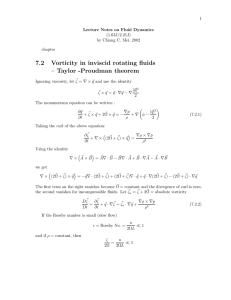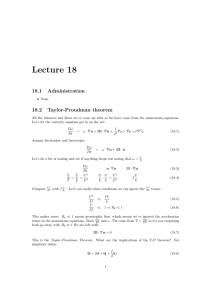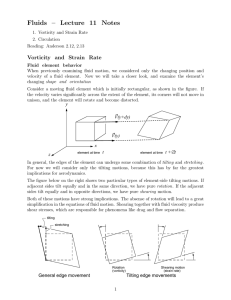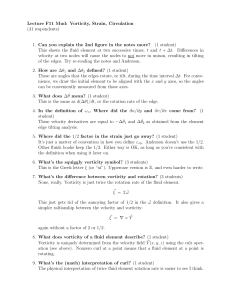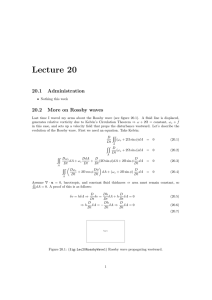Lecture 21 21.1 Administration 21.2
advertisement
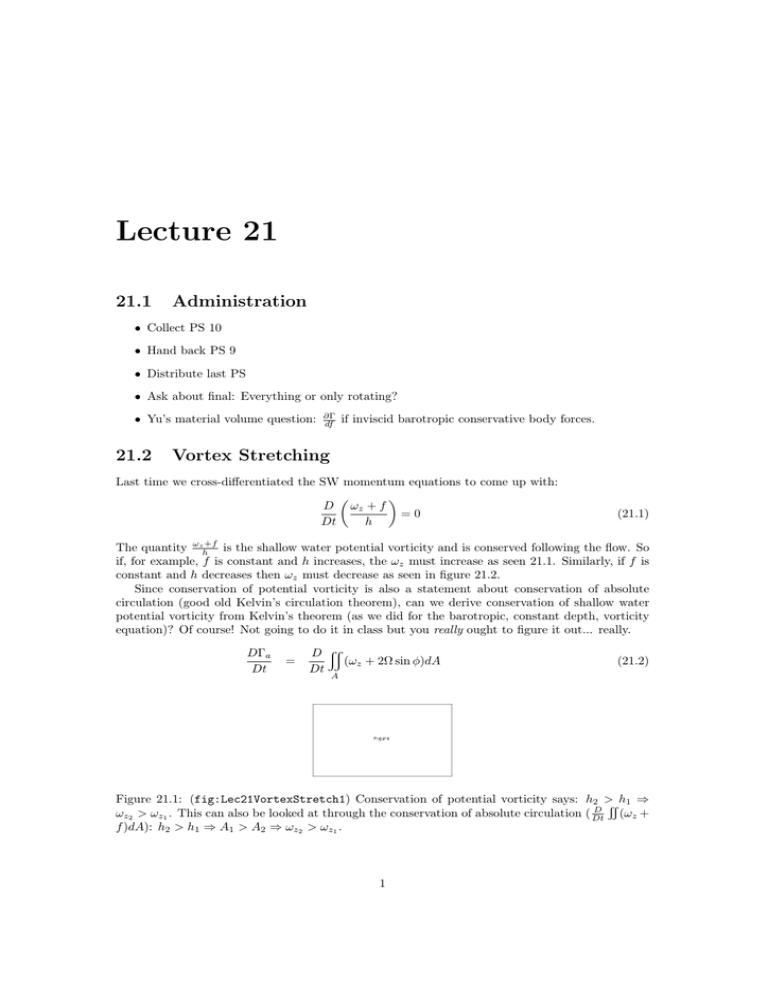
Lecture 21
21.1
Administration
• Collect PS 10
• Hand back PS 9
• Distribute last PS
• Ask about final: Everything or only rotating?
• Yu’s material volume question:
21.2
∂Γ
df
if inviscid barotropic conservative body forces.
Vortex Stretching
Last time we cross-differentiated the SW momentum equations to come up with:
D ωz + f
=0
Dt
h
(21.1)
The quantity ωzh+f is the shallow water potential vorticity and is conserved following the flow. So
if, for example, f is constant and h increases, the ωz must increase as seen 21.1. Similarly, if f is
constant and h decreases then ωz must decrease as seen in figure 21.2.
Since conservation of potential vorticity is also a statement about conservation of absolute
circulation (good old Kelvin’s circulation theorem), can we derive conservation of shallow water
potential vorticity from Kelvin’s theorem (as we did for the barotropic, constant depth, vorticity
equation)? Of course! Not going to do it in class but you really ought to figure it out... really.
DΓa
Dt
=
D (ωz + 2Ω sin φ)dA
Dt
(21.2)
A
Figure 21.1: (fig:Lec21VortexStretch1) Conservation of potential vorticity says: h2 > h1 ⇒
D
ωz2 > ωz1 . This can also be looked at through the conservation of absolute circulation ( Dt
(ωz +
f )dA): h2 > h1 ⇒ A1 > A2 ⇒ ωz2 > ωz1 .
1
Figure 21.2: (fig:Lec21VortexStretch2) Conservation
of potential vorticity says: h2 < h1 ⇒
D
ωz2 < ωz1 . Conservation of absolute circulation ( Dt
(ωz + f )dA): h2 < h1 ⇒ A1 < A2 ⇒ ωz2 <
ωz1 .
DΓa
Dt
DΓa
Dt
D
(ωz + f )dA
Dt
A
D
D
=
(ωz + f )dA + (ωz + f ) dA
Dt
Dt
=
(21.3)
(21.4)
A
D
dA
The first step was made because we have a Lagrangian dA. But now what to do with that Dt
term? This is an incompressible fluid, and no fluid is being pumped in or out of our cylinder
(unlike the Ekman pumping case), so
D
dV
Dt
=
0
(21.5)
D
(hdA) = 0
Dt
D
Dh
h dA + dA
= 0
Dt
Dt
D
1 Dh
dA = −
dA
Dt
h Dt
⇒
(21.6)
(21.7)
(21.8)
Substitute
DΓa
Dt
D Dt
=
A
Multiply and divide each term by
DΓa
Dt
DΓa
Dt
DΓa
Dt
1 Dh
(ωz + f )dA − (ωz + f )
dA
h Dt
=0
h
h
1 D
1
Dh
dA = 0
h
=
(ωz + f )dA − 2 (ωz + f )
h Dt
h
Dt
A
D
(ωz + f ) − (ωz + f ) Dh
h Dt
Dt
dA = 0
h
=
h2
A
D ω + f z
dA = 0
h
=
Dt
h
(21.9)
(21.10)
(21.11)
(21.12)
A
Note that the h needs to be there to have the right units! Make the usual argument that the
integral must be true for any area, so the integral must equal zero:
D ωz + f
dA = 0
(21.13)
h
Dt
h
D ωz + f
dA = 0
(21.14)
Dt
h
2
Figure 21.3: (fig:Lec21TopoSurf1) Barotropic, fixed depth fluid. h = ∆z
Figure 21.4: (fig:Lec21TopoSurf2) Shallow water, flat bottom fluid. h is in equations.
We got the same expression for conservation of shallow water potential vorticity from the traditional
approach of cross-differentiating, subtracting and simplifying and from Kelvin’s circulation theorem
(and from ∇ × { Du
Dt = ...}). But the latter approach is far more general. In the former approach
(cross differentiating etc.), the answer you got is completely dependent upon the equations you
start with. In the Kelvin’s circulation theorem approach, there is no such constraint. h is simply
the distance between two surfaces.
21.3
Conservation of potential vorticity
For barotropic and fixed depth (h = ∆z, see figure 21.3):
D ωz + f
= 0
Dt
h
1 D
(ωz + f ) = 0
h Dt
D
(ωz + f ) = 0
Dt
For shallow water, flat bottom (h is in equations, see figure 21.4):
D ωz + f
= 0
Dt
h
(21.15)
(21.16)
(21.17)
(21.18)
For shallow water, changing bottom fluid (h from equations and a representation of bottom
topography, see figure 21.4):
D ωz + f
= 0
(21.19)
Dt
h
For baroclinic density surfaces (multi-level shallow water) (h = ∆ρ; density coordinate system,
see figure 21.6):
D ωz + f
= 0
(21.20)
Dt
h
3
Figure 21.5: (fig:Lec21TopoSurf3) Shallow water, changing bottom fluid. h from equations and
a representation of bottom topography.
Figure 21.6: (fig:Lec21PressureSurfaces) Baroclinic density surfaces, h = ∆ρ.
For baroclinic potential temperature surfaces (h = ∆θ; isentropic coordinate system see figure
21.7):
D ωz + f
= 0
(21.21)
Dt
h
The take home message is this: potential vorticity (whatever the form) is conserved following the
fluid. For this course it’s fine to restrict ourselves to thinking in terms of ∆z but ∆θ and ∆ρ work
fine too. When we hold h to be constant, it is absolute vorticity that is conserved
D ωz + f
= 0
(21.22)
Dt
h
D
(21.23)
(ωz + f ) = 0
Dt
Thus ωz + f is constant.
21.4
Stability
Imagine zonal westerly flow with ωz = 0 at some latitude given by f0 , see figure 21.8. Above
(North) f0 , f > f0 ; below (South) f0 ,f < f0 . If a parcel of fluid was to move north of the f0 level,
it would move into a region of higher planetary vorticity. But to conserve absolute vorticity, a fluid
parcel in that situation would produce ωz < 0 bringing the parcel back to Jim –bottom is cut
off. Remember, h =constant and ∇ · u = 0 means the area of a column cannot Jim –bottom is
cut off. An identical argument can be made for a parcel moving south of the f0 level:
Figure 21.7: (fig:Lec21ThetaSurfaces) Baroclinic, potential temperature surfaces, h = ∆θ.
4
Figure 21.8: (fig:Lec21Stability) Wave motion caused by flow over topography.
Figure 21.9: (fig:Lec21TopoFlow1) Side view of flow over topography.
• moving to region of lower f
• to conserve ωz + f0 need ωz > 0
• this forces the parcel back to f0
Thus, westerly flow is stable to small meridional perturbations. When we allow fluid depth to
change with the flow, we no longer have
D
(ωz + f )
Dt
=
0
(21.24)
(21.25)
But rather
D
Dt
ωz + f
h
=
0
(21.26)
It is the potential vorticity that is conserved rather than the absolute vorticity. The classic “implications of conservation of potential vorticity” example is flow over a mountain (see figure 21.9
and 21.10).
You can think of this as a shallow water system if you like. Or as the lowest level of a multilayer fluid. Note that h2 = h4 > h1 = h5 > h3 . If we impose ωz1 = 0, then ωz5 = 0, ωz2 = ωz4 >
0, ωz3 < 0. The implications of this are seen in figure 21.10. The results of all of this are as follows:
• At 2 the increase in h demands an increase in (ωz + f ) resulting in northward curvature.
• Because f increases to the north ωz does not have to increase as much as it would if f were
constant.
Figure 21.10: (fig:Lec21TopoFlow2) Top-down view of flow over topography.
5
• Once fluid is over the mountain, the decrease in h demands a decrease in (ωz + f ), resulting
in southward curvature.
• The curvature will be largest when h is at the minimum at 3.
• By the time the fluid crosses the mountain it will be further south than its starting latitude,
in a region of smaller f .
• This smaller f will initially be helped by the relatively larger h at 4 imposing a larger ωz .
• But once beyond the mountain and h = h5 the fluid will still be in a region of lower f ,
requiring ωz > 0 ⇒ postive curvature.
• When the fluid is back at it’s starting latitude, it will have a component of +v that will drive
it north.
• Northward displacement ⇒ larger f ⇒ ωz < 0 ⇒ southward curvature.
• When the fluid is back at its starting latitude, it will have a component of −v that will drive
it south. (Jim – There might be something cut off on this page).
You end up with a wave pattern downstream of the mountain. The waves restoring force is a f .
This means that the wave is a Rossby wave. But this Rossby wave is governed by
D ωz + f
= 0
(21.27)
Dt
h
rather than
D
(ωz + f )
Dt
=
0
(21.28)
So we should expect a slightly different dispersion relation. Let’s come up with the shallow water
dispersion relation:
D ωz + f
= 0
(21.29)
Dt
h
D
h Dt
(ωz + f ) − (ωz + f ) Dh
Dt
h2
Dh
D
h (ωz + f ) − (ωz + f )
Dt
Dt
=
0
(21.30)
=
0
(21.31)
Recall that when we found the dispersion relation for a barotropic fluid of constant depth, we
started out by writing ωz , u and v in terms of a streamfunction. That was fine for constant depth
because the flow was 2D (w = 0). Streamfunctions are no good here. We need something else.
Expand:
Dωz
Dh
Df
h
+h
− (ωz + f ) +
=
Dt
Dt
Dt
∂f
∂ωz
∂ωz
∂ωz
∂f
∂f
∂f
∂ωz
+h
−
+u
+v
+w
+u
+v
+w
h
∂t
∂x
∂y
∂z
∂t
∂x
∂y
∂z
∂h
∂h
∂h
∂h
=
(ωz + f )
+u
+v
+w
∂t
∂x
∂y
∂z
∂ωz
∂h
∂ωz
∂ωz
∂h
∂h
+ hβv − (ωz + f )
=
h
+u
+v
+u
+v
∂t
∂x
∂y
∂t
∂x
∂y
6
0
(21.32)
0
(21.33)
0
(21.34)
Split terms into mean and perturbation bits. Strictly we do not need the mean terms to be constant
in time. By definition they are a solution to the equations, so they just drop out. Also you risk
missing important stuff by neglecting wave-mean flow interaction.
h = h̄ + h u = ū + u v = v ωz = ω¯z + ωz
∂
∂
(h̄ + h )
(ω¯z + ωz ) + (ū + u ) (ω¯z + ω ) + v (ω̄ + ω ) + (h̄ + h )βv −
∂t
∂x
∂
∂
∂
(h̄ + h ) + (ū + u ) +
(h̄ + h ) + v (h̄ + h )
=
(ω¯z + ωz + f0 + f )
∂t
∂x
∂y
∂ω
∂h
∂ω ∂h
+ h̄βv − (ω¯z + ωz + f0 + f )
=
(h̄ + h )
+ ū
+ ū
∂t
∂x
∂t
∂x
∂ω ∂h
∂ω ∂h
=
h̄
+ h̄ū
+ h̄βv − (ω̄ + f0 )
+ ū
∂t
∂x
∂t
∂x
(21.35)
0(21.36)
0(21.37)
0(21.38)
To clean things up let’s set ū = 0 and ω̄z = 0:
h̄
∂h
∂ω + h̄βv − f0
=0
∂t
∂t
(21.39)
Thus, we have a single equation with three different variables: ωz , v , h . How do we reduce three
to one? We can do it if we assume that to first order, the flow in the system is geostrophic. From
shallow water equations, the geostrophic means are:
x:
fv
y:
fu
∂h
∂x
∂h
= −g
∂y
= g
(21.40)
(21.41)
(21.42)
Linearize (f = f0 + f , h = h̄ + h , u = ū + u , v = v ) but for now take ū = 0:
(f0 + f )u
y:
f0 u
u
∂
(h̄ + h )
∂y
∂h
= −g
∂y
g ∂h
= −
f0 ∂y
= −g
(21.43)
(21.44)
(21.45)
Similarly
v =
From before:
∂
h̄
∂t
Substitute:
h̄
∂
∂t
∂
∂x
g ∂h
f0 ∂x
∂v ∂u
−
∂x
∂y
g ∂h
f0 ∂x
+ h̄βv − f0
(21.46)
∂h
=0
∂t
∂
g ∂h
g ∂h
∂h
−
+ h̄β
− f0
=0
∂y
f0 ∂y
f0 ∂x
∂t
h̄βg ∂h
∂h
∂ 2 h
g h̄ ∂ ∂ 2 h
+
+
− f0
=0
2
2
f0 ∂t ∂x
∂y
f0 ∂x
∂t
∂h
∂ 2 h
f02 ∂ ∂ 2 h
h
+β
+
−
=0
2
2
∂t ∂x
∂y
∂x
g h̄
(21.47)
−
7
(21.48)
(21.49)
(21.50)
Figure 21.11: (fig:Lec21Disp1) QG: ω versus k and l.
Figure 21.12: (fig:Lec21Disp2) QG: ω versus k and l; negative k.
This is the quasi-geostrophic form of the linearized vorticity equation. Why QG? Got the vorticity
equation from the full momentum equations, but then substituted in geostrophic form of velocity.
You’ll learn lots more about this in subsequent courses. The QG vorticity equation is in the form
of one unknown. Assume a solution of the form:
h = Hei(kx+ly−ωt)
(21.51)
Substitute and get:
ω
= −
ω
= −
βk
k2
+ l2 +
βk
k 2 + l2 +
f02
g h̄
1
2
Rd
(21.52)
(21.53)
where Rd is the Rossby radius of deformation. This QG Rossby dispersion relationship is identical
to the last dispersion relationship except for the Rd term. Rd is the fundamental horizontal scale
where both gravity and rotation are important. If a petrubation length scale is small relative to
Rd then the resulting adjustment doesn’t really feel rotation. ⇒ Same system same pert structure,
different pert length scale (Jim – bottom cut off ).. Note that for reduced gravity, Rd = g h̄/f ,
meaning the wave is slower. Rearranging things:
ω
βRd
= −
Rd2 k 2
Rd k
+ Rd2 l2 + 1
(21.54)
Show Pix (see figures 21.11, 21.12, 21.13, 21.14, 21.15, 21.16, 21.17) (Jim – You may want
to add some comments to the plots).
The phase speed is
cx =
ω
β
=− 2
k
k + l2 +
1
Rd2
(21.55)
This is always eastward and note there is a max speed for small k and l, opposed to the barotropic,
fixed h case where we have cx → ∞ as k and l → 0. The group speed is
cgx
=
∂ω
∂k
(21.56)
8
Figure 21.13: (fig:Lec21Disp3) QG: ω versus k for l = 0.
Figure 21.14: (fig:Lec21Disp4) Fixed h: ω versus k and l.
Figure 21.15: (fig:Lec21Disp5) Fixed h: ω versus k and l.
Figure 21.16: (fig:Lec21Disp6) Fixed h: ω versus k for l = 0.4.
Figure 21.17: (fig:Lec21Disp7) Fixed h: ω versus k for l = 0.
9
=
1
β(2k 2 − k 2 + l2 + Rd
2 )
2
1
k 2 + l2 + Rd
2
(21.57)
This can be east or west depending on combination of k and l. This can also happen for internal
waves: group speed up, phase speed down.
10
